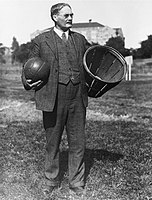
Photo from wikipedia
This study was performed aimed at comparing multidirectional bilateral and unilateral jump performance and passive range of motion (ROM) of lower limbs between soccer and basketball young players and evaluating… Click to show full abstract
This study was performed aimed at comparing multidirectional bilateral and unilateral jump performance and passive range of motion (ROM) of lower limbs between soccer and basketball young players and evaluating associations between inter-limb ROM asymmetry and bilateral jump performance. A total of 67 young male athletes participated in this study, who were classified as soccer (n = 40; 15.55 ± 1.5 y; 1.76 ± 0.12 m; 58.15 ± 10.82 kg; 19.84 ± 2.98 kg·m2) and basketball (n = 27; 15.7 ± 1.66 y; 1.76 ± 0.12 m; 62.33 ± 16.57 kg; 19.84 ± 2.98 kg·m2) players. Participants were asked to perform bilateral and unilateral multidirectional jumps, and passive ROM of hip (flexion, extension and abduction), knee (flexion) and ankle (dorsiflexion) joints was also assessed. Significant between-group differences were observed for hip extension with flexed knee ROM in dominant (soccer: 142.43 ± 7.74°; basketball: 148.63 ± 8.10°) and non-dominant (soccer: 144.38 ± 8.36°; basketball: 148.63 ± 6.45°) legs; hip flexion with flexed knee ROM in dominant (soccer: 13.26 ± 4.71°; basketball: 9.96 ± 3.42°) and non-dominant (soccer: 12.86 ± 4.55°; basketball: 9.70 ± 3.62°) legs; and for the ratio of hip abduction (soccer: 1.02 ± 0.08; basketball: 0.97 ± 0.11). However, no significant between-group differences were observed for bilateral and unilateral jump capacity, or for inter-limb asymmetries (dominant vs. non-dominant leg). Finally, no associations were observed between ROM ratio (dominant vs. non-dominant leg) and bilateral jump performance. These findings lead to the suggestion that differences on passive ROM values in young male athletes may be sport-specific. Additionally, there seems to be need for the implementation of training strategies specifically aimed at improving bilateral or unilateral jump ability, or at diminishing inter limb passive ROM differences in order to improve multidirectional jump performance for neither soccer nor basketball youth male players.
Journal Title: PLoS ONE
Year Published: 2021
Link to full text (if available)
Share on Social Media: Sign Up to like & get
recommendations!